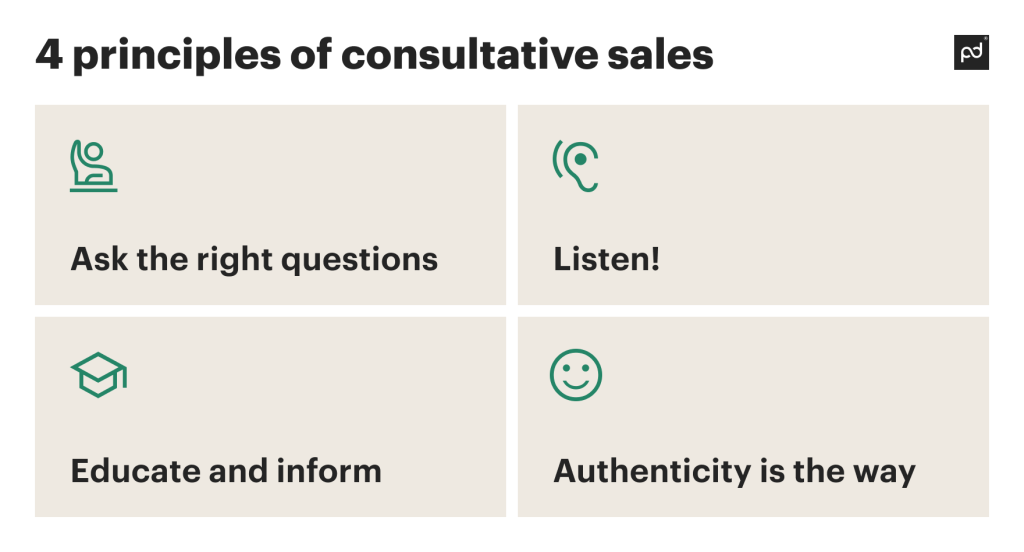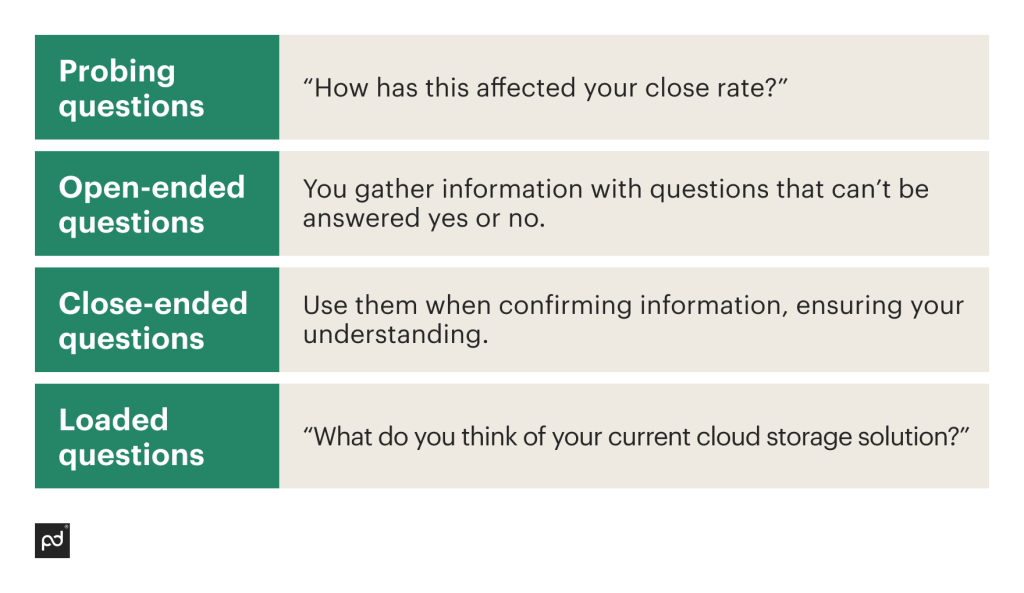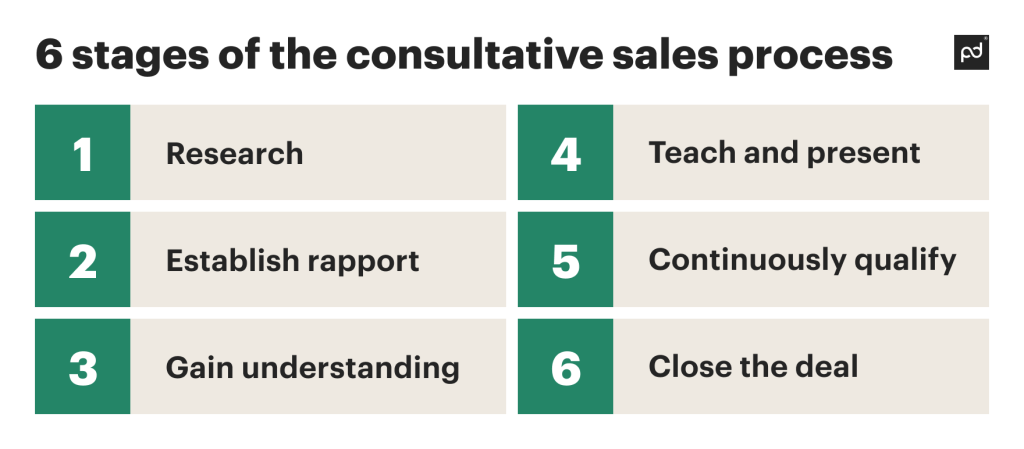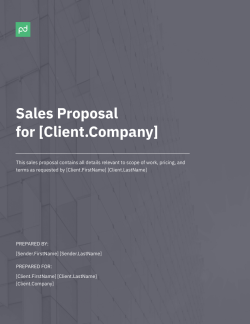A recent report found that only 49% of Americans trust businesses today.
Modern consumers spend more time doing their own research and less time listening to sales pitches.
Consultative selling offers a less pushy, customer-centric approach to the buyer’s journey.
Read this guide to learn the ins and outs of consultative sales.
Key takeaways
- Consultative sales is customer-centric and focuses on building relationships.
- Consultative selling requires empathy, active listening, and problem-solving.
- Salespeople act as advisors to clients. Sometimes, their product isn’t the best solution, so they find something that works for the prospect.
- Solution selling is pitching products and solutions to leads. Consultative selling pitches education and authenticity.
- Tools like CRM and document workflow management software are key to a seamless transition to consulting sales.
What is consultative sales?
Consultative sales, by definition, is a selling strategy that focuses on meeting customer needs.
Salespeople gain a deeper understanding of prospective customers, demonstrating knowledge and building trust.
Consultative sales teams act in an advisory role.
Consultative sellers build tailored solutions before writing out a sales proposal.
Speaking of sales documents, check out our free sales proposal template before negotiating your next deal.
What is consultative selling?
So, what is consultative selling besides gaining trust?
A consultative selling approach requires active listening, problem-solving, and customized deals.
Consultative sellers accept if the best solution isn’t from their company this time. They nurtured existing relationships for conversion in the long term.
Why consultative selling works
Consultative selling works because it nurtures rapport and understanding, offering customers relief from high-pressure tactics.
Consultative sales emphasize shared values and are about how you can help guide clients to the best solution.
Modern consumers are happy to spend time researching products and services themselves.
A recent HubSpot survey found that 96% of customers do research before speaking with a sales rep. Prospects are more likely to reach your funnel armed with information, so they already have a good idea of what they need.
According to a Garner survey, buyers who experience a self-driven learning path are 147% more likely to buy more than initially planned.
A consultative approach to sales gives buyers all the necessary information and time. Even unqualified leads may turn into revenue later down the line.
Why is consultative selling important?
Let’s delve into the pivotal role consultative selling plays in fostering meaningful client relationships and driving long-term business success.
Customers view you as genuine and not pushy
A consultative sales strategy encourages asking questions and listening to responses, showing prospects that you understand their pain points.
Salespeople present custom solutions and not cookie-cutter pitches.
Putting customers first shows the value your brand offers, even when your solution isn’t the right fit. It may not be a “yes” now but there is always next time.
Better understand your customers
Typical product-led solutions involve forcing round holes into square pegs.
Consultative sales teams put customer needs first, with sales professionals asking probing questions and adapting pitches to every lead.
A deeper understanding of customer needs leads to insights that build trust.
Customer knowledge even transfers to other areas, such as improving client onboarding.
Give customers what they want
Let’s say you go to a restaurant and order a steak.
You wait in anticipation only for the waiter to bring out a tuna steak. Sure, you like tuna steaks, but that’s not what you wanted.
The waiter replies, “The tuna is the best, trust me,” and leaves you and your unwanted dish at the table.
How satisfied would you be with that experience?
So, why do sales teams continue to push what is “best” for the customer? Giving prospects the chance to speak ensures you meet their needs and give them what they want.
Build lasting relationships
Consultative selling puts you in the driver’s seat as an expert and client advisor. They share what they know. You provide them with information and possible solutions.
It’s not essential if the solution helps you make the sale. What’s important is that the solution presented is useful to the lead.
For instance, let’s say you give a sales lead a presentation full of insights. This information scores them points with their manager.
But then it turns out they don’t have buying authority. Regardless, they’ll be sure to get in touch the next time they are looking for a problem-solver.
High adaptability
Many sales teams fail because they try too hard to force a product or service down the prospect’s throats.
This simplifies pitches and lets them work efficiently with hot leads. However, they are unable to think creatively and adapt to solutions.
Consultative sales teams first listen to what the customer has to say. It is then up to them to create a solution for a flexible toolbox of products and offers.
Offering tailored solutions widens the net for more qualified leads — some might just take a bit more effort!
Top benefits of consultative selling
Adopting a consultative sales approach positions organizations as trusted advisors, fostering continued growth. Here are some of the benefits.
- Increased customer satisfaction (CSAT): You offer personalized presentations and custom solutions. Bespoke experiences only help to increase CSAT.
- Greater customer loyalty and retention: Reps communicate and interact with customers with authenticity. A recent survey found that 74% of customers are loyal when brands make them feel understood and valued. Finding a tailored solution shows that you care about them and not just revenue.
- Higher win rates and conversion rates: Taking a customer-centric approach builds greater trust. Salesforce reports that 86% of business buyers are more likely to buy if they understand their goals.
- Competitive advantage: A consultative approach better aligns your business with current market trends. Customers find traditional sales tactics exhausting, so an empathetic approach is refreshing.
- Enhance the skills of your sales team: There’s less memorizing of pitches. Consultative selling requires your team to upskill. Consultative selling requires more of everything. More listening, more creative thinking, more problem-solving, and more touchpoints.
Consultative vs. solution selling: what’s the difference?
Solution selling differs from consultative selling in many ways.
Firstly, solution selling pitches your products based on the problems they solve. For example, you sell customer relationship management (CRM) software.
One product is for small businesses, while a separate one is for enterprises. In solution selling, you would pick one and explain how that product solves issues with a sales proposal.
Consultative selling doesn’t focus on what solutions or products you offer. Instead, consultative selling focuses on the customer. What are their problems?
What products or services will solve those problems? Consultants advise prospects along the path to finding the answer to their questions.
Consultative salespeople must be quick on their feet and prepared to seize opportunities. At times, this requires an ability to be flexible and depart the standard pitch route.
Taking a consultative approach allows your team to flex their problem-solving muscles and gain respect and trust from leads.
4 principles of consultative sales
Follow these four principles of consultative selling to optimize your approach.
By doing so, you can unlock a range of benefits that contribute to successful and effective sales strategies.

1. Ask the right questions
Many sales pitches feed reps the “right” questions to ask.
Many times, question lists are concise to keep the discussion moving along in a predetermined direction. But that doesn’t work if you gain understanding and build trust.
You need to get to the bottom of why the lead has come to you. What are their pain points, and what are they hoping to achieve?
What do they expect will change if they find the right solution?
Find out the intimate details of your prospect by asking these types of questions.

Probing questions
Ask questions that dig deeper into customer answers and seek opportunities to gain specifics about pain points.
For example, a customer says they experience long delays getting signatures for contracts. Ask them, “How has this affected your close rate?”
Open-ended questions
You gather information with questions that can’t be answered yes or no.
After asking, sales teams can sit quietly and let the customer discuss things. Even a tangent may offer greater insight into customer needs.
Close-ended questions
There’s a time and place for yes or no questions. Use them when confirming information, ensuring your understanding.
This also shows the customer that you are paying attention to their every word.
Loaded questions
Traditional pitches use loaded questions to steer conversations. Consultative selling is no different. Use these questions to move on to the next phase of your discussion or to garner information.
For instance, you could ask, “What do you think of your current cloud storage solution?”.
This instantly moves the discussion to what is or isn’t working.
It also gleans information about the competition that may prove helpful later on.
2. Listen!
Salespeople are used to giving pitches and presentations. In other words, consultative sales teams know when to shut up and listen. Doing this successfully comes down to active listening.
Active listening starts with the 80/20 rule. Speak 20 percent of the time and listen 80 percent of the time.
Maintain positive body language during discussions. This includes upright posture, eye contact, and head nodding. Part of active listening involves repeating things back to the speaker.
This assures you don’t get anything wrong but also shows you are listening.
You want to facilitate a productive conversation by using the right environment.
Pick a quiet, distraction-free environment to host a meeting. Consider taking notes on your laptop or with a trusty notepad.
Note-taking helps for recall and demonstrates the importance you place on what the prospect is saying.
3. Educate and inform
Now that you’ve listened, it’s time to respond with insights and information. Consultative selling is about demonstrating and delivering value.
Teach prospective buyers about what’s available on the market and (hopefully) how your solution is best.
To do this properly, sales teams must be armed with evidence.
This could be market data and case studies. At the same time, authority starts with intimate product knowledge.
Customer reviews and testimonials are great ways to show the value of your solutions. Ideally, you can find customers with similarities.
In B2B, this would be a testimonial from a customer in the same industry and/or similar size and turnover.
Provide answers and materials to educate your customers.
Educational resources can be anything from how-to videos to competitor analysis sheets. These materials allow prospects to dive in on their own time when convenient.
4. Authenticity is the way
Authenticity is the backbone of a consultative approach. If you can’t show a genuine interest in solving the prospect’s problem, you won’t build trust.
Show sincerity at every stage of the process, from research to close.
During conversations, ask questions like “What else is needed to solve your issues?” Or “What else can we do to help you find a solution?”
Refer to notes, your CRM platform, or whatever works best for you. Do this for each prospect before every interaction. This will help you recall information and show the prospect you care about them.
Top consultative sales approach strategies
Explore these tactics to effectively implement a practical consultative sales approach. By incorporating these strategies, you can enhance your sales process and build stronger, more collaborative relationships with clients.
Prepare before the first interaction
Customers are researching your brand before making it to the sales funnel.
You need to put the same effort into the consultative selling process. Do the necessary research before engaging a new lead.
Make sure you know details about them, like job title, company, and how they arrived at your solution. In B2B, this includes company details such as industry, size, and turnover.
Information gathering is integral for any meeting or pre-call planning. Being prepared helps your team ask the right questions.
Always build trust
Fans of Glengarry Glen Ross are familiar with the concept of Always Be Closing.
Well, in consultative selling, you should Always Build Trust. You don’t do this with aggressive one-size-fits-all tactics.
Active listening and preparation prove your worth to a new lead. Educating them with solutions further deepens the relationship. Build rapport, and the clients will return when it’s time for advice on another problem.
Follow-up every time
During customer interactions, many new details may emerge. At least they will if you ask the right questions.
Follow up on these details with insight and examples of how your product is relevant.
Of course, you may not be able to answer every question.
That’s okay. Let them know you’ll find the answer and get back to them. The key to consultative selling is to always follow up.
Follow up with answers and educational materials. Even if the prospect doesn’t purchase, you’ll have proven reliable and delivered value.
Have a problem-solving mindset
Remember, your sales team isn’t here to pitch the benefits or advantages of your service.
They’re offering their services as a problem-solver to the prospect. Sales reps base success on whether or not they can guide the client to the right place.
Train your team to laser-focus on identifying pain points. At the same time, they need to look for problems that clients may not be aware of.
For example, a client states they are happy with a communications solution “even though it limits webinars to 40 participants”. A consultative seller picks up on the “even” and now knows a new problem they can add to their consulting proposal.
Sometimes, this means helping out unqualified leads. However, solving problems reinforces trust and authenticity.
Understanding customer needs in consultative selling
A consultative approach leads to a higher understanding of prospect needs. Sales teams focus on gathering information, forming insights, and solving problems.
During the process, it may turn out that customer needs are slightly different than expected.
SDR and closers give prospect feedback to management.
New insights optimize marketing efforts and even inform product development. All ways to better fulfill customer needs.
How to use consultative selling to close a sale
Consultative selling is about building a rich relationship based on trust. Early stages involve research and listening to the prospect. Use gathered information to communicate why you want to help the customer.
For instance, it could be, “I know our document workflow management software can save you money from unnecessary paperwork.”
Follow up with educational materials and tailored solutions, strengthening the relationship. Over time, qualified leads view consultative reps as expert advisors. Your sales team leverages these relationships to close deals now and in the future.
A guide to the 6 stages of the consultative sales process
Our concise guide will walk you through the six distinct stages that form the foundation of successful consultative selling.

Research
Your sales team needs to exploit every resource available to gain lead intelligence.
This includes reading websites, social media, industry publications, and print media. In B2B, search places like TrustPilot and G2 to see what a prospect’s clients say about them.
Know their industry and details such as the number of employees and who has the buying power.
Establish rapport
Reach out to clients and start building relationships. Ask the right questions to further qualify leads and establish authentic problem-solving interest.
Relate to their company values, and build connections through shared beliefs, experiences, and culture.
Gain understanding
Ask the right questions to unearth client pain points and other details. Spend the majority of this time listening and waiting for a response.
Always pay attention to what they say during discussions and recall key points. Use this stage to assess the needs of the prospect and discover potential opportunities.
Teach and present
Use marketing and sales materials to educate prospects on your products and those of your competitors. Show how your proposed solution checks every box on the checklist of client needs.
There will be a bit of give and take during this educational stage. The client may bring up new concerns, objections, or insights.
Take note of these comments and resolve them as best as you can. And remember to always follow up on any issues that require more research.
Continuously qualify
You’re constantly qualifying leads during a consultative approach. As you better understand the prospect, you either qualify or don’t.
When you recommend solutions, their reactions or new information may qualify them further.
You can continue with your guidance even if leads become unqualified.
For example, a small business may not have the budget for your product.
So, you help them find an affordable alternative. The business grows, and a few years later, they return to purchase your product.
Close the deal
The final stage of any sales approach is to close. You’ve presented a custom solution.
The lead agrees that this solution solves the problem. Now it’s time to commit the prospect to making the purchase.
During closing, it’s vital to re-emphasize yourself as an advisor and not a salesperson.
You’re happy you could help find a solution together and look forward to the next time.
Follow up with converting customers to ensure they know you are always available to help. By reinforcing your relationships, clients will likely return for the next purchase.
2 consultative selling examples
Take a closer look at several real-world examples of consultative selling in action. These provide practical insights into applying this approach in various business scenarios.
Healthcare
A company sells medical equipment. Marketing targets a hospital. A sales rep spends time discovering more about the organization.
During discussions, the hospital manager complains about floor spacing and equipment footprints. The rep offers to help find a solution and puts together a presentation on portable medical equipment.
Together, the hospital leaders and the sales executive find the best option.
Weeks later, the rep follows up with the client and finds out they are now looking for more accurate diagnostic equipment.
The customer asks the rep for their advice, and the cycle continues.
SaaS
A salesperson receives an opportunity from marketing. The lead signed up for an e-book on the benefits of cloud-based document solutions.
The sales rep researches the client and discovers they are a senior VP of IT operations at a large enterprise. Research produces an article on how the company is steeped in monolithic, on-premise architecture.
The article quotes the CEO, “This year is going to be a digital transformation.”
Armed with this knowledge, the rep reaches out to the VP. They ask about the current issues the IT department is facing and what they think needs to be done.
Eventually, they present a tailored solution using document management software to reduce the burden on IT.
They highlight less paperwork and speedy document generation. The VP thinks the solution is perfect and gets approval from all stakeholders.
Consultative sales skills and techniques to succeed
Now, let’s discover the essential consultative selling techniques and skills that are pivotal for success. Explore proven strategies to build strong client relationships and navigate the intricacies of consultative selling with confidence.
- Be an industry expert: Know the market trends and be up-to-date on the competition.
- Have natural, regular conversations: Check in with prospects and customers on a regular basis. You’re not always selling, you’re investing in more robust relationships.
- Be a product expert: The easiest way to show expertise and gain trust is to know your products and services cold. Salespeople should be able to answer common questions and adjust strategy mid-discussion.
- Use the right tools: Lead intelligence tools and CRM platforms help you keep track of essential details. Document workflow management software like PandaDoc reduces manual tasks and centralizes sales materials.
- Be honest, be authentic: Being truthful and transparent pays off in the end. If you can’t offer a solution that works for the client, be honest. They’ll repay you with trust.
- Workshop active listening: Use coaching and roleplaying to teach active listening skills. They understand prospects and present better solutions with higher win rates.
- Manage conversations: Use loaded and probing questions to steer conversations. They also help to capitalize on momentum but must be able to find a balance between a structured sales pitch and a real conversation.
Impress prospects and shorten your sales cycle with PandaDoc software
Consultative selling is all about impressing prospects with useful information and tailored solutions.
Honest, authentic interactions build trust and help qualify prospects for conversion.
Consultative sales tactics require a different approach.
Taking time to understand customers better may seem a daunting and lengthy process. Use consultative tools like PandaDoc for sales enablement.
Our platform gives your team a central space to keep tabs on prospects.
You can tailor deals in minutes from ready-made templates and seamless document generation. Our quote builder creates quick estimates.
Customize presentations and level up the experience with custom branding.
As client advisors, your team will likely know when to close.
However, analytics such as document views instill confidence in your closers.
So, sign up for a 14-day trial today and find out what PandaDoc can do for you.
Frequently asked questions
-
Empathy is at the core of consultative selling. Truly understanding client needs requires active listening and emotional intelligence. Effective salespeople wait patiently for prospects to respond. They pay attention, remember specific details, and recall key talking points.
Consultative sellers must place themselves in the shoes of the customer. Doing so helps them find high-tailored solutions that they would want themselves.
-
Yes. A consultative sales approach applies to all types of B2B and B2C industries. Sectors such as retail, healthcare, finance, and software all work with consultative selling. This is because the main purpose is to build relationships and find solutions. Both objectives can prove valuable to retail, healthcare, finance, software, marketing, and telecommunications.
-
The consultative sales cycle depends on many factors, including product type, industry, and price point. It is often used for products with longer buying cycles, like SaaS. Each stage takes a week or several weeks to complete. Consultative stages include research, needs assessment, education, solution finding, and closing.
A crucial but overlooked aspect is the follow-up stage of consultative sales. Following up is part of the sales cycle regardless if the prospect converts at the end or not.
-
Sales teams can transition to a consultative sales approach through proper planning and training. Train sales professionals on topics such as empathy, active listening, and being customer-focused.
You also need to use tools that help you better understand and manage relationships. CRM, lead scoring, and document management solutions streamline the consultative process.
Disclaimer
PandaDoc is not a law firm, or a substitute for an attorney or law firm. This page is not intended to and does not provide legal advice. Should you have legal questions on the validity of e-signatures or digital signatures and the enforceability thereof, please consult with an attorney or law firm. Use of PandaDoc services are governed by our Terms of Use and Privacy Policy.
